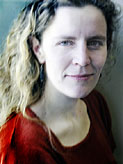Rethinking campus sustainability
Rethinking campus sustainability McGill University
User Tools (skip):
Rethinking campus sustainability
Spring is the season of greening, and McGill may soon find itself in full blossom as sunshine and sustainability come to campus.
 Management PhD student Amelia Clarke
Management PhD student Amelia ClarkePhoto: Claudio Calligaris |
|
Amelia Clarke, a management PhD candidate with a research interest in sustainable development, who gave a presentation at McGill's Rethink Forum March 28, talks a little faster when discussing McGill's environmental potential. Finally, she said, McGill is beginning to catch up with its peers.
Students can take much of the credit. Ever since a group of 11 McGill students attended a Sierra Youth Coalition environmental conference two years ago, campus groups have changed from pushing for policy change to proposing specific programs. It is a pattern that has been repeated since the Sierra Youth Coalition began its sustainable campus project in 1998.
"[The Sierra Youth Coalition] has been the networker," Clarke said. "It's been the training ground. It's been the inspiring ground. It started with Mount A[llison], then the University of Victoria got enthusiastic the next year, then Dal[housie], then Waterloo." Clarke is proud of the students and proud of the program, and understandably so: she founded the Sierra Youth Coalition seven years ago.
According to Clarke, a year or two after a delegation of students participates at a Sierra Youth Coalition conference, their university creates an environment office. McGill followed this trend and, next October, the university will have a chance to showcase its other accomplishments when it hosts the latest Sierra Youth Coalition conference. As has been the tradition, other schools will likely draw inspiration from McGill initiatives such as the use of Eco Logo cleaning products, sleep functions on all computers, and the geothermal exchange system used in the Lady Meredith House. "Two years from now people will say, 'That campus modelled itself after McGill.'"
Clarke wants to goad McGill on to excellence, and she plans to do so by sharing with the Sub-committee on the Environment examples of top-quality practices at other universities and uncovering the failings in our own—like the McGill School of Environment's use of single-pane windows. "It's a heating nightmare!" she complained, "and so easy to fix."
One of the plans she will be pushing comes from the University of British Columbia. Though their implementation has been slow, Clarke believes the West Coast campus has an excellent strategic vision that is both detailed and encompassing, including everything from sustainable transportation to academic development. They also have a "Greening the Campus" course, a hands-on program which teaches students about university environmental management techniques and provides free research to the administration.
Much of the problem in environmental management comes from a lack of feedback and an administrative short-circuit, explained Clarke. Many university administrations tend to jump from policy to implementation. Rather than first translate a recycling policy into a target of, say, a 80 percent recycling efficiency, universities will often content themselves by setting up a few recycling bins. Since such a program has no specific goal, its success cannot be measured.
While waiting for McGill to decide upon its goal, Clarke is measuring McGill's recycling status by sending her students rummaging through dumpsters. Her research methods class collected a day's worth of trash from the Bronfman, Thomson House, and Shatner Buildings, then sorted it into garbage, recyclables and compost. In doing so, the students discovered a shocking amount of waste, including stacks of unopened paper, a brand new pair of shoes and, from Shatner alone, enough food for a small wedding party. They also found many objects that belonged in blue boxes.
At Thomson House, only 11.2 percent of garbage could have been recycled. The building earned a 83.2 percent efficiency mark, an excellent showing considering many of the students doing the waste audit couldn't have achieved perfect scores. They were uncertain whether items such as plastic forks or coffee cup lids were recyclable (they're not). In Bronfman, 57.5 percent of waste could have been recycled, a score that Clarke attributes to attitudes and infrastructure. "If I want to recycle a can right now," Clarke explained from the fifth floor of the Bronfman Building, "I need to bring it down to the basement."
Clarke believes that the university must do better. She explained that universities are well situated to be environmental leaders—their research shapes debate and policy and their education moulds tomorrow's leaders—and stressed that sustainability should be an important part of a university's mandate. "We're one of the core institutions of society. If the university ignores their role [as environmental leader], who's going to take it on?"
For the time being, McGill seems prepared to accept that role, an opportunity that Clarke knows from experience can't be wasted. Dalhousie, her former university, lost its green thumb in 1995 when the student leaders graduated and the new university president proved unenthusiastic about the issue. "Everything that got put in place stayed, but all of the big steps stopped," Clarke said.
She is buoyed by Principal Heather Munroe-Blum's recent endorsement of the Subcommittee on the Environment's work and she feels that the momentum is gaining. "All the players are engaged and motivated," she said. "I think McGill could become a real environmental leader."

